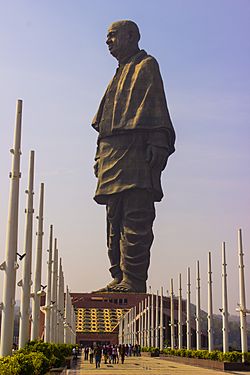Statue of Unity facts for kids
 |
|
| Coordinates | 21°50′17″N 73°43′09″E / 21.8380°N 73.7191°E |
|---|---|
| Location | Narmada Valley Kevadiya, Narmada, Gujarat, India |
| Designer | Ram V. Sutar |
| Type | Statue |
| Material | Steel framing, reinforced by concrete and brass coating, bronze cladding |
| Height | 182 meters (597 ft) |
| Beginning date | 31 October 2013 |
| Completion date | 30 October 2018 |
| Opening date | 31 October 2018 |
| Dedicated to | Vallabhbhai Patel |
The Statue of Unity is the world's tallest statue. It stands 182 metres (597 feet) tall and is located in Gujarat, India, near the town of Kevadia. This amazing statue honors Vallabhbhai Patel (1875–1950). He was an important leader in India's fight for freedom.
Patel was the first deputy prime minister and home minister of independent India. He worked closely with Mahatma Gandhi. People remember him for bringing many different parts of India together after it became free. The statue is built on the Narmada River, facing the Sardar Sarovar Dam. It is about 100 kilometres (62 mi) southeast of Vadodara city.
The idea for the statue was first shared in 2010. Construction began in October 2013. An Indian company called Larsen & Toubro built it. The total cost was about ₹27 billion (around US$299 million). The famous Indian sculptor Ram V. Sutar designed the statue. India's Prime Minister, Narendra Modi, officially opened it on October 31, 2018. This day marked 143 years since Patel's birth.
Contents
What Makes the Statue of Unity Special?

The Statue of Unity is the tallest statue in the world. It is 182 metres (597 ft) high. This makes it 54 metres (177 ft) taller than the previous record holder, the Spring Temple Buddha in China. Before this, the tallest statue in India was a 41 m (135 ft) tall statue of Lord Hanuman in Andhra Pradesh. You can see the Statue of Unity from as far as 7 km (4.3 mi) away!
The statue is built on a small river island called Sadhu Bet. This island is about 3.2 km (2.0 mi) from the Narmada Dam. The statue and its surrounding area cover more than 2 hectares (4.9 acres). They are surrounded by a 12 km (7.5 mi) long artificial lake. This lake was made by a weir (a small dam) on the Narmada river.
Exploring the Statue's Zones
The statue has five different sections, but only three are open to visitors.
- Zone 1: This is from the base up to Patel's shins. It has three levels. Here you can find an exhibition area, a memorial garden, and a museum.
- Zone 2: This part goes up to Patel's thighs.
- Zone 3: This section reaches the viewing gallery, which is 153 metres (502 ft) high.
- Zone 4: This area is for maintenance workers only.
- Zone 5: This includes the head and shoulders of the statue.
The museum in Zone 1 tells the story of Patel's life and his important work. There's also a special audio-visual room. It shows a 15-minute film about Patel and the local tribal culture. Inside the statue's legs are concrete towers with two elevators each. These lifts can take 26 people up to the viewing gallery in just over 30 seconds. The viewing gallery can hold up to 200 people at a time.
Visiting the Statue of Unity
The Statue of Unity quickly became a popular place to visit. In its first eleven days after opening in November 2018, over 128,000 tourists came to see it. It has even been named one of the '8 Wonders of SCO' by the Shanghai Cooperation Organisation.
In its first year, nearly 2.9 million people visited the statue. It earned about ₹82 crore (820 million Indian Rupees) from ticket sales. By March 2021, 5 million tourists had visited. By November 2022, that number reached 10 million. In its first five years, the statue welcomed over 15 million visitors in total!
Images for kids
-
Vallabhbhai Patel was a key leader in India's freedom movement. He helped unite 562 small states to form modern India.
See also
 In Spanish: Estatua de la Unidad para niños
In Spanish: Estatua de la Unidad para niños












